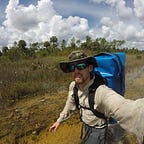Turtle Powered Elevator?
Sea Turtle Hatchling Emergence
People run. Feet burning, faces wincing, regret building with every second on the sizzling pavement. “It’s only a little ways. I’ll just leave my sandals in the car”. Admonishing themselves as they run on tip-toes through the parking lot, lunging for the sand like sprinters for the finish line. Oh, the sweet relief of the ever so slightly cooler sand!
The beach is packed. Laden with chairs and children, coolers and towels people traipse through the soft, white sand, hunting for an unclaimed spot of shoreline. Sunbathers, readers, sand castle architects, runners, and snorkelers, all slathered in sunscreen bask in the sun before them. It’s summertime in Florida and most are only vaguely aware of the small, caution taped squares of sand at the top of the beach.
But, just under the swaying yellow tape, roughly a foot below the surface, 120 perfectly spherical sea turtle eggs lie in the womb of the beach. It’s early August and this buried treasure has sat motionless, spun like a rotisserie under the blazing summer sun, for over 2 months now (74 days).
An abundance of summer rain this year has quite likely kept the nest cooler, resulting not only in eggs that take longer to incubate, but also possibly skewed sex ratios. When it comes to many reptilian species the hotter the nest temperature the more females it will produce and vice versa. A phenomenon known as temperature dependent sex determination (TSD). Or more simply put, hot chicks, cool dudes.
With hundreds of nests dotting the beach, it’s nearly impossible to predict the exact time a nest will hatch; but, down in the silence of this chamber, there’s sudden a twitch — a faint spasm from one of the golf ball sized eggs at the top of the pile. In the darkness, a small surgical slit appears along the side of the egg, cut by the hatchling’s egg-tooth. Fluids begin to seep out, followed closely by the nickel sized head of a hatchling loggerhead. As it wriggles out of its shell, bumping into other eggs as it goes, a domino effect ensues. Soon hatchlings are slicing out of their inflated eggs throughout the chamber creating more and more space as they do (the once inflated eggs took up more space than the hatchlings alone).
Once all the siblings are out of their eggs, there is a lull in activity. All eagerly await the cue to go. Now, in the sea turtle world, nighttime affords the best protection for emerging hatchlings to successfully reach the sea, but there is no way of telling how light it is when you’re buried under a foot under the sand. So, instead, these hatchlings will wait for the temperature of the sand to cool. Though this doesn’t always mean night time — storms can trigger this as well — it is often a reliable environmental indicator that it’s time to go.
On the surface, beach-goers pack up their kids and coolers, shake off the sand and trudge back to their cars. Exhausted, but satisfied as the day comes to end.
On a collision course, the sun nears the horizon while the hatchlings approach it from below, destined to soon switch places.
With frantic bursts of energy, followed by periods of recovery, the turtles work as a team. Individuals on the top and sides of the pile dig away at the roof and walls while those at the bottom pat the sand into the floor as it falls. This effectively creates a turtle-powered elevator, raising the floor as they tear down the ceiling.
While the elevator is being hoisted higher and higher, the sinking sun above slides behind a closing curtain of rain before the last of its rays are swallowed by the ocean.
Darkness ensues and the scene is set. With one final push, the pile undermines the integrity of the roof and a section collapses. Starlight streams in. New eyes adjust. The last of the sand filters through the frenzy of turtles until it’s patted into the floor and the elevator dings. Top floor, the race is on.
A torrent of turtles begins to boil out of the hole. Utilizing ancient cues and senses, the hatchlings are able to immediately hone in on the direction of the ocean. Frantic flippers swing wildly as they climb over one another fleeing down the beach. Footprints and beach cart tracks from earlier in the day become hills and valleys, sandcastles and holes divert and swallow the eager hatchlings making their journey that much more difficult and tiring. But, under the cover of darkness, they bravely soldier on and within just a few minutes over 100 hatchlings are swept into the waiting arms of the sea. An unmistakable example of the connection between land and sea, sewing the two worlds together at the seams.
Their journey has only just begun.
Back in the egg chamber, nothing moves. The eggshells buried in the sand will be absorbed into the earth, giving nutrients to new life. The tracks, so daintily etched into the sand will soon be blown and washed away, leaving no sign that anything ever happened to the returning sunbathers and snorkelers.
All 7 sea turtle species are considered either threatened or endangered. If you are lucky to come across a scene like this please stay back and give them space. Keep all lights, including camera flashes off, for this can cause the turtles to become disoriented and even crawl in the wrong direction. If you’re at the beach during the day make sure to clean up as best you can and fill in any holes you find. These hatchlings have a long way to go and will need all the energy they can muster.
